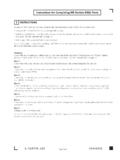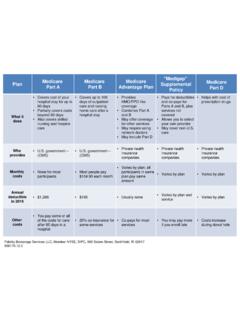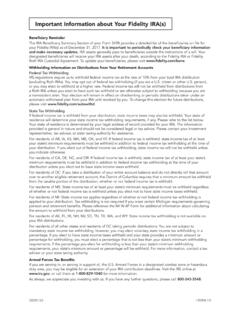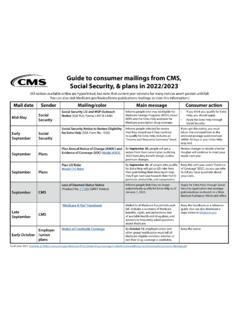Transcription of A Fidelity Investments Webinar Series Understanding ...
1 BROKERAGE: TECHNICAL ANALYSISU nderstanding Indicators in Technical Analysis638855738A Fidelity Investments Webinar Series2 Technical Analysis Webinar SeriesGetting Started with Technical Analysis Learn the assumptions that guide technical analysis, and get to know the basics of trend trading. Understanding Indicators in Technical AnalysisIdentify the various types of technical indicators, including trend, momentum, volume, volatility, and support and Chart Patterns with Technical AnalysisUse charts and learn chart patterns through specific examples of important patterns in bar and candlestick Risk with Technical AnalysisManage your trading risk with a range of confirmation Our CoauthorCharles D.
2 Kirkpatrick II, CMTC harles D. Kirkpatrick II, CMT, is president of Kirkpatrick & Company, Inc., a technical analysis research firm that publishes the Market Strategistinvestment newsletter. A past instructor in finance at the School of Business Administration at Fort Lewis College and adjunct professor of finance at Brandeis University International Business School, he is a two-time winner of the Chartered Market Technicians Association s prestigious Charles H. Dow Award for research in technical analysis, winner of the MTA Annual Award in 2008 for Outstanding Contributions to the Field of Technical Analysis, and winner in 2012 of the Mike Epstein Award from the MTA Educational Foundation for Long-Term sponsorship of Technical Analysis in Academia.
3 He is a Chartered Market Technician, a past member of the board of directors of the Market Technicians Association, past editor of the Journal of Technical Analysis, past board member and vice president of the CMT Association Educational Foundation and a member of the American Association of Professional Technicians (AAPTA). He coauthored Technical Analysis: The Complete Source for Financial Market Technicians, the primary textbook for the CMT program and for university graduate courses on technical analysis, authored Beat the Marketand, most recently, Time the Markets: Using Technical Analysis to Interpret Economic is a graduate of Phillips Exeter Academy, Harvard College (AB), and the Wharton School (MBA) and lives with his wife in Maine.
4 4 BROKERAGE: TECHNICAL ANALYSIST echnical Indicators Basics Volatility IndicatorsTechnical Indicators BasicsTrendIndicatorsVolumeIndicators AgendaMomentum Indicators Support & Resistance IndicatorsTechnical Indicator Basics6 BROKERAGE: TECHNICAL ANALYSISWhat Is a Technical Indicator?A technical indicator is a mathematical calculation based on historic price or IndicatorsSimple Moving Average (SMA), Exponential Moving Average (EMA), Moving Average Convergence/Divergence (MACD), Average Directional Movement Index (ADX)Momentum IndicatorsStochastic Oscillator, Relative Strength Index(RSI)Volume IndicatorsOn Balance Volume (OBV), Money Flow Index (MFI), Accumulation/DistributionVolatility IndicatorsBollinger Bands , Average True Range (ATR)
5 Support and Resistance IndicatorFibonacci Retracements Types of Technical IndicatorsTrend Indicators9 BROKERAGE: TECHNICAL ANALYSISS imple Moving AverageHow It WorksDetermine trend direction If the SMA is positively sloping, the trend is up. If the SMA is negatively sloping, the trend is trend duration 200-bar SMAs are common proxies for long-term trends. 50-bar SMAs are typically used to gauge intermediate trends. Shorter-period SMAs can be used to determine short-term trading signals via price crosses When prices cross above the SMA, you may want to go long or cover short.
6 When prices cross below the SMA, you may want to go short or exit Moving Average (SMA)This is the easiest moving average to construct. It is calculated as the average price over the specified period. The average is called moving because it is plotted on the chart bar by bar, forming a line that moves along the chart as the average value changes. TREND INDICATOR10 BROKERAGE: TECHNICAL ANALYSISS imple Moving AverageUsing moving average crossovers to generate trading signalsWhen a more sensitive (faster) SMA crosses above a less sensitive (slower) SMA from below, it is considered a more sensitive (faster) SMA crosses below a less sensitive (slower) SMA from above, it is considered INDICATOR11 BROKERAGE: TECHNICAL ANALYSISE xponential Moving AverageHow It WorksIdentify trends earlier Use the same rules that apply to SMAs when interpreting EMAs.
7 Keep in mind that EMAs are generally more sensitive to nearer-term price trend direction When the EMA rises, you may want to consider buying when prices dip near or just below the EMA. When the EMA falls, you may consider selling when prices rally toward or just above the support and resistance areas A rising EMA tends to support the price action, while a falling EMA tends to provide resistance to price Moving Average (EMA)The EMA measures trend direction over a period of time. It applies more weight to data that is more current.
8 Because of its unique calculation, EMA will follow prices more closely than a corresponding INDICATOR12 BROKERAGE: TECHNICAL ANALYSISE xponential Moving AverageBoth the EMA and the SMA here represent 30 reacts faster to the first pullback and the subsequent INDICATOR13 BROKERAGE: TECHNICAL ANALYSISM oving Average Convergence/DivergenceHow It WorksDetermine bullish or bearish MACD crossing above the zero line is considered bullish, while crossing below the zero line is bearish. When MACD turns up from below the zero line, it is considered bullish.
9 When it turns down from above the zero line, it is considered bearish. When the MACD line crosses from below to above the signal line, the indicator is considered bullish. The further below the zero line this cross occurs, the stronger the signal. When the MACD line crosses from above to below the signal line, the indicator is considered bearish. The further above the zero line this cross occurs, the stronger the Average Convergence/Divergence (MACD)MACD is a momentum oscillator primarily used to trade INDICATOR14 BROKERAGE: TECHNICAL ANALYSISM oving Average TREND INDICATOR15 BROKERAGE: TECHNICAL ANALYSISA verage Directional Movement IndexHow It WorksMeasure strength of trend A strong trend is present when ADX is above 25; no trend is present when ADX is below 20.
10 If the ADX is declining, it could indicate that the current trend is weakening. If the ADX is rising, it could indicate a strengthening trend. The ADX indicator incorporates two different components in its construction which are commonly plotted along with the ADX. Positive Directional Indicator (+DMI)shows the difference between today s high price and yesterday s high price. These values are then added up from the past 14 periods and then plotted. Negative Directional Indicator ( DMI)shows the difference between today s low price and yesterday s low price.














